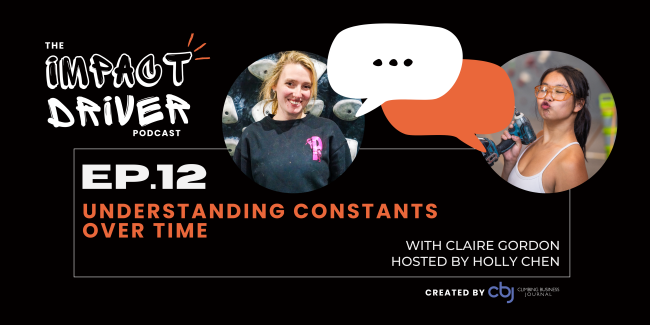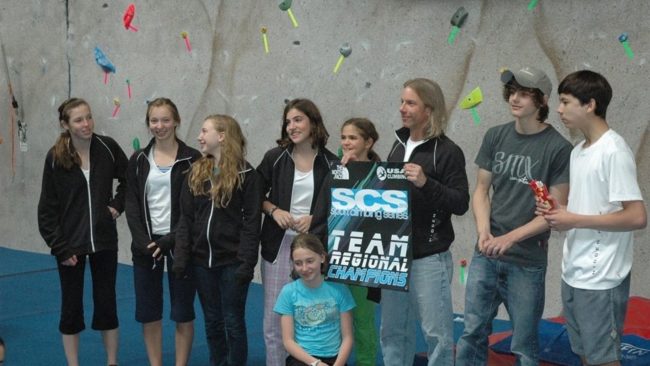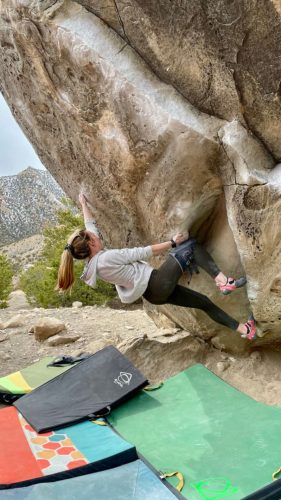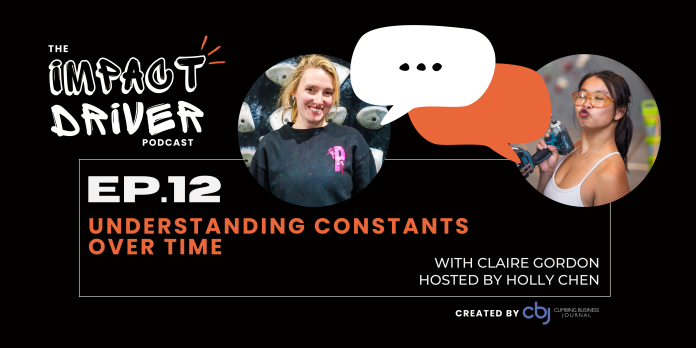
Today The Impact Driver host Holly Chen meets with Claire Gordon, a former competitive youth athlete turned coach and gym owner. Claire has a bachelor’s degree in psychology with an emphasis on development psychology, and her coaching spans from coast to coast; from First Ascent in Chicago to Planet Granite Portland (now Movement), ABC Kids Climbing in Boulder, and finally starting her own independent team, PinkPoint Training, in 2023. At PinkPoint, Claire does everything from coaching to administration to sponsorships and, of course, routesetting. If asked what her proudest climbing accomplishments are, Claire will say it’s her kids. Her athletes have gone to youth nationals, youth worlds, and are becoming lifelong lovers of the sport. In the summer of 2024, Claire achieved a lifelong dream of opening her own climbing gym and began The Campus Climbing in North Boulder, due to open in early 2025.
In this conversation, Claire and Holly talk about routesetting for a targeted, specific audience: elite youth athletes. They also talk about the unique structure of independent youth teams, what comp climbing really is, and how unpredictable it can be for climbers and coaches during comp day. They get into the weeds about coaching movement techniques and handling emotional pressure. And with Claire’s extensive experience coaching with commercial gyms, they cover how to translate her tailored routesetting and coaching skills to commercial gyms. Last but not least, they talk about the old school routesetting mindset of forcing movement and how that can be a disservice to not just youth athletes, but the community at large.
We hope you enjoy this episode of the Impact Driver Podcast!
Thank you Approach and Kilter for your support!
And thank you Devin Dabney for your music!
Timestamps
00:00 – Intro
04:38 – About Claire Gordon
05:21 – About Team PinkPoint
07:43 – The Kilter Space
08:13 – The Campus x Team PinkPoint
10:10 – Value of Teams like PinkPoint
11:58 – Competition Climbing
12:59 – Targeting Routesetting for a Specific Audience
16:34 – Competition Simulation
19:05 – Utilizing Existing Routesetting in Gyms for Youth Athletes
20:28 – More Targeted Routesetting
27:11 – Training Time
30:29 – What to Set for Athletes
32:20 – Uncertainty in Competitions
34:06 – Ad Break
36:12 – Constants in Competitions
38:58 – Setting for Learning
40:24 – Leveling-Up Moves
46:43 – Tips for Setting for Kids
49:29 – Breaking Beta
55:39 – How can Routesetters be Better for Youth Programs
59:26 – Funny Moments with Youth Athletes
01:02:04 – Closing
Abridged Transcript
Can you tell the audience who you are and what you do in a couple of sentences?
I’m Claire. I grew up as a comp climber competing in the US as well as in France, and then transitioned into a coach. I have been working professionally in climbing as a coach for the last eight or nine years. And in the last year and a half, I started my own team called PinkPoint Training. We are an independent team, which means we’re not affiliated with a specific gym. And in the last couple weeks, I became part of a brand-new gym opening in Boulder.
…Can we talk about the structure of an independent team? What does it mean to be not affiliated with a climbing gym?
…I am not an employee of a gym, and our athletes are not affiliated with a gym, meaning their shirts don’t say a gym on them. They aren’t tied to any memberships or anything, and we just bounce around between gyms. So, I do have contracts with a number of different gyms that allow me to come in and use their space, but we are contractors instead of employees.

…Can you tell me whether PinkPoint inspired the opening of [The Campus Climbing]? Is it because you wanted a space for PinkPoint athletes to train? Is it because you had a specific vision or mission in mind?
I think they go hand in hand, but it’s really important to me: this gym is not the PinkPoint gym. It’s not for our team. I tell my kids all the time that we could still get kicked out of this gym, which is mostly a joke. We probably won’t, but they could. So, really, while I would love to provide a space for our team, I really want to create a space where everyone who’s interested in training at a high level can come together and train, be that a 13-year-old kid who’s training for nationals, a 20-year-old who’s training for adult nationals, a 50-year-old who’s trying to send V10 again like they did back in the day, or really anyone in between. I’d like to create a space where anyone looking to train at a high level is an equal.
…Why do you think teams like PinkPoint are important to have in this community? When you started PinkPoint, what is it? What do you see missing in the current youth competitive field that made you want to start PinkPoint?
Yeah, I think there’s a number of things that play into that and the bottom line is that a lot of coaches are not full-time coaches. They have many other roles within their gym. And I was feeling that myself trying to make ends meet financially and coach, I just didn’t have the bandwidth to pour 100% into the team and really give them the attention they deserve. And so, something really important to me is that is all I do: PinkPoint. I don’t also work a front desk shift. I’m there for my team, and when I routeset it is for my team, I’m able to set maybe for their weaknesses, maybe to build their confidence, set more compy moves. And something really special that we’re able to do is tweak the climb as we’re trying it…
…In addition to setting for your athletes, you are also, at some point, simulating a comp environment where that emotional side of the comp comes in…So in addition to simulating the climbing, you’re also simulating the emotional pressure?
Yeah. A lot of what we do in our setting is actually trying to simulate that emotional pressure. And I would never want to tell the kids this, but sometimes we’re like, “This top is just messed up. I don’t know if anyone’s going to match this, but let’s just see.” And then we see, do they break in that moment? And that’s a learning opportunity to be like, “Cool. How did you handle that? You went up there, you fell trying to match the top, and you had 15 seconds left, and you decided to get back on. That was bad time management,” or “You fell matching the top one minute in, and then you just cried for the rest of your three minutes. That was poor emotion management.” And hopefully, we can work out all these kinks before the comp. But I say that and we will never, ever be able to work out all the kinks before the comp because you just can’t simulate the pressure of how much it matters when you’re there.
And you mentioned earlier that you still split your time between taking your kids to commercial gyms under contracts. How do you utilize commercial gyms’ existing routesetting that you are not creating for your athletes to help them perform or improve?
Anytime an athlete gets to onsite a climb that is good training for us. So, bouncing around between gyms is really beneficial, because almost every time we go into a gym, there’s something new for our kids to climb, and we have no idea what we’re going to get at a comp. I think sometimes people are like, “When we show up to nationals, it’ll be triple paddle dynos and bat hangs and it’s going to be crazy.” And then they just get a crimp power block. And they’re like, “What?” But we do still see that in comps, and it is important to be prepared for anything. And so that’s really cool, too. We get to climb on so many different people’s routesetting, and they get so many opportunities to onsite. We’re not seeing what a kid specifically wants to work on…
…How do you split this? Like, on the simulation comp days, and on tweak and fun days, and your train at other gym days: how do you divide the time between these [days] with your athletes?
Yeah, so it really depends on where we are in the season. So, let’s say in September the kids go back to school, we start back up with practices. There’ll be much more of learning movement, learning technique, playing with climbing, playing with different moves, just learning and experiencing together, and then the phase we were just in. So, we had nationals at the beginning of July, and I would say in June right before that, we’re really not fine-tuning a lot of the technical aspects, and we’re more fine-tuning the mental aspects, doing more mock comps, trying to expose them to different moves. And something we get to do in our routesetting, too, is build our kids’ confidence…

There are definitely, and correct me if I’m wrong, parts of your training and your routesetting for your kids that are constant. For example, things that we see in comps a lot. We’ll probably see a rose move. We’ll probably see a run and jump. We’ll probably see paddles in various difficulties and levels. How do you go about helping your kids learn and learn them to a point where it’s almost second nature, these constants that do appear in competition?
In climbing, I think this idea of constants is they’re constant over time. And I think that causes a lot of conflict for kids and adults. They’ll watch a comp, and they’ll be like, “That comp had no dynos.” I’m like, “Yeah, we see comps with no dynos, but as a general average across time, we do see dynos. Right?” But that doesn’t mean that every single comp you go to will have a dyno. I think in our regionals this year, there were zero dynos. And I had kids be like, “What the heck? I trained dynos, and then I didn’t see a dyno.” Yeah, that will happen. But these kind of general movement patterns, we try to teach them movement and understanding of their body in space, rather than “Here’s how you do this paddle,” because you’ll never, ever see this paddle again, so it doesn’t matter. But do you understand how you’re generating movement? Where is your belly button over your toe? Where are your hips? Did you generate three times and let go when your hands were at your hips? Did you let go when your hands were at your shoulders? How much did you drive through your legs? When did you let go of the right hand versus the left hand? So, it’s less about learning the move…
…Let’s say you’re setting a learning moment for me. I need to learn how to dyno and how my body works, moves through space. You set the easy level. I do it…How do you as the routesetter and coach now level that up?…
There’s so many different parts to it and I really like to do it in multiple parts. So, I’d be like, okay, I’m going to lower the feet. Same thing, but the feet are lower, so the way you generate is a little different. And we talk about how moving those feet change the experience. Okay, now I’ll put the feet back and I’m going to move the hand further. So you get that same initial generation from your feet, but you’re going to a further hold. Okay, we’ll talk about how to do that. Okay, now I’m going to put the feet lower again and keep the hand further. Can we still do this? Okay, now I’m going to downsize the feet and it’s really incremental. And we will talk together about, “Well, what did that do for you, for me to change that? Why did this get harder?…
…Most coaches who work at commercial gyms are oftentimes also routesetters, or routesetters are also coaches or coaches have a background in routesetting, competition climbing. So, in your experience and just all these years of coaching and routesetting, what are some of the common mistakes you see in routesetting at a commercial facility that can hinder an elite athlete’s performance and training?
Yeah, I think the biggest one is I work with kids who are 4’9” and very legitimately can climb V12. If they can reach it, they can climb it. And I think a lot of those kids are not able to actually be pushed to their full potential because the routesetting doesn’t allow it. Those kids sometimes just stop being able to reach at V5. And I think there’s a misconception on, “Well, if we set for kids, then it’s stupid easy if you’re six feet tall.” And that’s just not true, right? Like, a 4’9” kid and a six-foot-tall dude or lady could [project] the same climb. Maybe there’s a foot that the 4’9” kid is using, but the six-foot-tall person would just never consider using it. It’s just us adding a small foot option all of a sudden that gave the kid the opportunity to proj V10….
…What are some things, or, I don’t know, questions to ask yourself or step by steps that a commercial routesetter can do if they want to begin to set for their elite team or their younger sibling who just started climbing?
Yeah, I think the very first thing is meet those kids. Talk to them. I just had a conversation with a very experienced routesetter, someone who set at a national level, who looked at me and said, “Oh my gosh, 4’8” is so much smaller than I thought it was.” I had texted them and been like, “Yeah, one of my kids is 4’8”, can you try [to set] a climb? And they were like, “For sure. He can totally reach everything.” And then the kid got on the climb, and he was like, “Oh, no, 4’8” is so short.” So the first step is just meet these kids, get to know them, watch them climb. I think a lot of routesetters clock out at 4:00 or 5:00 and then the youth team shows up at 5:00. And so a lot of them have never even seen who these kids are. And all of my favorite routesetters, all of the best route setters in my experience know the kids, even if that’s just because they climbed with them once…

…Let’s say you’re a routesetter who does not coach; for example, me. But I still care deeply about the development of the climbing team or the next generation of youth climbers coming up to crush and show us what’s cool. How can I be a better routesetter and how can I collaborate with the coaching department more? What are some questions that we can be asking as routesetters? Specifically, the routesetters who don’t coach.
I think I’ll go back to my number one thing of meet the kids, know a couple kids names, know how they climb. And then the more conversations you can have with the coaching staff, like, “What is your team struggling with?” And they could just say, “Oh, we have a bunch of kids who are having a hard time with dynos,” and maybe you see a few more dynos in that week’s set. The members won’t be upset because I bet the reason the kids are struggling with it is they don’t see it in your routesetting often. So, I bet your members are struggling with it, too. The youth team often doesn’t exist in just a separate bubble, but they have eyes watching them all the time and the coaches can provide you feedback. I think if more gyms could create intentional feedback patterns and not just coaches being like, “This sucks, there’s nothing for my kids,” and routesetters being like, “Shut up, you have no idea what you’re talking about.” I think there’s a tension, but there doesn’t have to be….
…One last quick question. Can you share a funny thing that your athlete has said to you? Because kids say the funniest things sometimes.
…We actually walked into the [Longmont Climbing Collective] comp this year—brand new gym. I think you actually set for this QE. We walk in, we’re looking at it, and two of our little kids were talking together, and one of them was like, “Wow. The starts of these climbs look hard,” but he’s kind of talking quiet and the other one loudly. There happened to be a moment of silence, and he’s like, “Decking builds character.” And everyone turned around, and they’re all wearing their PinkPoint shirts, and they’re looking at me, and I’m like, “I promise I didn’t teach them that.”

Holly grew up in Taiwan and Hong Kong. Now she lives in Denver where she reports, writes and routesets. Beyond the Climbing Business Journal, her writing has been published by Alpinist Magazine, Climbing Magazine, Gym Climber and Sharp End Publishing. Holly’s motto has always been: “keep it interesting.”
Read our interview with Holly: Storytelling Through Movement










